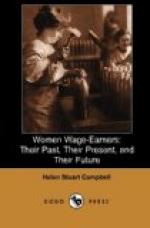Innumerable difficulties hedged about the enumerators for 1860. Rooted objection to answering the questions in detail was not one of the least. Unfamiliarity with the newer phases of the work was another, and thus it happened that the volume when issued was full of discrepancies. The tables of occupations, for example, characterized but a little over two thousand persons as connected with woollen and worsted manufacture; while the tables of manufactures showed that considerably more than forty thousand persons were engaged, upon the average, in these branches of manufacturing industry.
The returns gave the number of women employed in various branches of manufacture as two hundred and eighty-five thousand, but stated that the figures were approximate merely, it being impossible to secure full returns. It was found that three and a half per cent of the population of Massachusetts were in the factories, and nearly the same proportion in Connecticut and Rhode Island; but details were of the most meagre description, and conclusions based upon them were likely to err at every point. Its value was chiefly educative, since the failure it represents pointed to a change in methods, and more preparation than had at any time been considered necessary in the officials who had the matter in charge.
The census for 1870 reaped the benefits of the new determination; yet even of this General Walker was forced to write: “This census concludes that from one to two hundred thousand workers are not accounted for, from the difficulty experienced in getting proper returns. The nice distinctions of foreign statisticians are impossible.” And he adds:—
“Whoever will consider the almost utter want of apprenticeship in this country, the facility with which pursuits are taken up and abandoned, and the variety and, indeed, seeming incongruity of the numerous industrial offices that are frequently united in one person, will appreciate the force of this argument.... The organization of domestic service in the United States is so crude that no distinction whatever can be successfully maintained. A census of occupations in which the attempt should be made to reach anything like European completeness in this matter would result in the return of tens of thousands of ‘housekeepers’ and hundreds of thousands of ‘cooks,’ who were simply ‘maids of all work,’ being the single servants of the families in which they are employed."[17]
This census gives the total number of women workers, so far as it could be determined, as 1,836,288. Of these, 191,000 were from ten to fifteen years of age; 1,594,783, from sixteen to fifty-nine; and 50,404, sixty years and over, the larger proportion of the latter division being given as engaged in agricultural employments.




